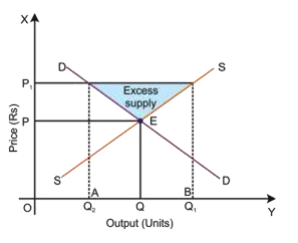A consumer consumes only two goods X and Y. Marginal utilities of X and Y is 3 and 4 respectively. Prices of X and Y are Rs 4 per unit each. Is consumer in equilibrium? What will be further reaction of the consumer? Give reasons.
Consumer will attain its equilibrium (maximum satisfaction) at the point, where marginal utility of a product divided by the marginal utility of a rupee, is equal to the price.
Consumer’s equilibrium = 
In case of two goods, a consumer equilibrium attain where:
For goods X,
For goods Y,
Here, 
Hence consumer is not in equilibrium, Thus, in order to attain equilibrium consumer will increase the consumption of good Y and decrease the consumption of good X.










